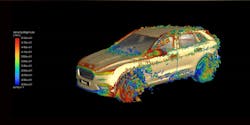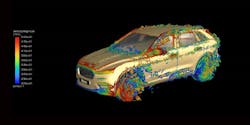ML-Enhanced Computer-Aided Engineering in the Cloud
In addition to its deep history in the industry and broad catalog of CAE solvers, Ansys is no stranger to the use of machine learning to accelerate simulation. For example, its CFD software, Fluent, has incorporated Reduced Order Model (ROM) techniques for more than five years. Similarly, its process integration and design optimization software, optiSLang, employs the Adaptive Metamodel of Optimal Prognosis (AMOP) approach.
However, Ansys’ latest machine learning offering, SimAI, looks to exceed the capabilities of its previous ML implementations while also striving to simplify ML model training and prediction. Launched in January 2024, SimAI is the company’s cloud-based machine learning platform. Users upload simulation data to Ansys’ AWS account where it, and all generated data, is segregated from other user’s data and secured using AES-256 encryption.
Ansys SimAI Leverages Metamodel Machine Learning
Once uploaded and collected into training and testing datasets, simulation data—be it concerned with fluids, structures, electromagnetics, etc.—is used to train what the company refers to as a physics-driven deep learning approach to ML training. Specifically, Ansys says it falls in the category of metamodel machine learning but uses a combination of techniques, including neural networks. The result is that SimAI isn’t parameter-dependent but can accommodate simulation data that shares similar (though not identical) topologies.
READ MORE: Crunching the Numerics: Computer Aided Engineering
Whatever the technique, the trained model(s) live in the SimAI cloud, accessed through a web portal. To use them, an engineer could upload new geometry (as an .stl file for example) and choose an appropriate ML model to extrapolate a result. Post-processing is also handled in the cloud, resulting in the colorful visualizations common with CAE post-processing.
The advantage of cloud-based, as opposed to local, training is the dedicated storage to house and organize what can be voluminous amounts of training data. In addition, cloud-solutions can also provide access to higher-end GPUs, and the large amounts of VRAM required for training an ML on large datasets, than users may have available locally.
Even with these advantages, any ML training process can be an involved process. According to Ansys AI’s principal product manager, Ilya Tolchinsky, SimAI users should start with no less than 30 simulations to train a reliable model. Further, depending on the model’s complexity, training may take anywhere from 48 hours to five days to complete.
That’s a sizable time commitment, but a finished ML model becomes a permanent asset engineers can use to explore multiple design “what-ifs” in minutes rather than the hours/days it would take to run multiple traditional CAE simulations. According to Ansys, SimAI users can expect an adequately trained ML model to return results 20 to 200 times faster than a traditional solver.
While speed is great, it doesn’t mean much without accurate results. It should be noted that, in the same way solver-based simulation is an approximation of real-world physics, any ML trained model is an approximation of solver results—in short, an approximation of an approximation.
READ MORE: Expert Pointers and Insider Strategies for Peak CAD Performance
That said, SimAI incorporates two methods to help users achieve acceptable accuracy in their ML models. As with other ML approaches, SimAI saves a percentage of simulation data to test the trained ML model for accuracy.
In addition, it provides a confidence score for each what-if scenario explored. The closer a particular ML prediction resembles a known solution included in the simulation training data, the higher the score. The company says SimAI models, trained on a sufficient amount of diverse training data, can return predictions that match simulation results within a few percentage points.
A Good Start for Future Simulation
While the application of machine learning to simulation has accelerated rapidly in terms of power and ease-of-use in the past five years, it’s still early days for the melding of these technologies. Given the industry’s current trajectory, it’s not hard to imagine a not-too-distant future in which CAD design, traditional simulation and ML would all be offered, and linked together, as a comprehensive Software-as-a-Service (SaaS) option.
Leveraging cloud-based storage and enterprise-grade GPUs, users could design online, prep and simultaneously run multiple simulations of that design, and then package those simulations into the datasets used to train one or more ML models. No doubt that’s easier said than done. Still, it’ll be interesting to see how things develop in the next five years.
Editor’s Note: This article is a companion piece to Mike McLeod’s feature,“Crunching the Numerics: Computer Aided Engineering.” Sign in to read his complete analysis of how simulation software leaders employ machine learning to hyper-accelerate FEA/CFD.
About the Author

Mike McLeod
Mike McLeod is an award-winning business and technology writer with more than 25 years of experience, as well as a former engineering trade publication editor.

